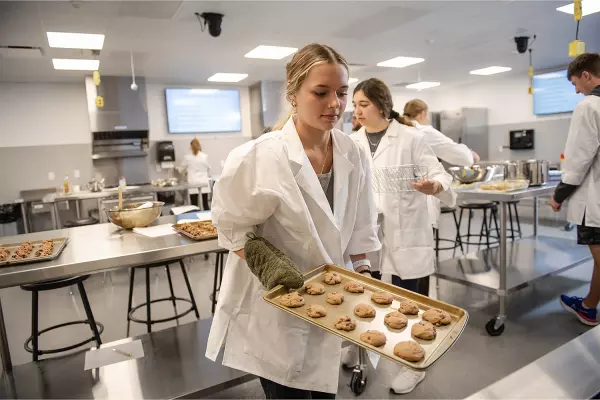
Newly-opened Archer Dietetics Foods Lab to benefit AU's growing dietetics program
As the name indicates, the new Archer Dietetics Foods Lab will benefit the dietetics program at Ashland University.
But it should also be a positive for the rest of the university, the community and even other Ohio colleges.
“We envision using this space for other things because it’s not all about dietetics,” Denise Reed, director of AU’s dietetics program, said recently in the 2,000-square-foot renovation with the other full-time dietetics faculty member, David Vanata.
The new lab opened at the start of the semester on the lower level of the John C. Myers Convocation Center in the former Accent Room restaurant space and already has been the site of two introductory nutrition classes.
The facility has eight instructional stations, a teaching station, flexible preparation tables and a sizable pantry area. It coincides with the dietetics program’s 10th graduating class this academic year.
“The dietetics program now has a facility that is commensurate with the quality of instruction,” said Rick Ewing, vice president of operations and planning at AU. “This lab may also be used in a variety of ways, including cooking classes and culinary demonstrations.”
Designed by the DesignGroup Architects and constructed by the Adena Corp., the project took about eight months to complete and cost around $900,000 with a large portion of the funds gifted by donors Bob and Jan Archer.
“We are grateful to Bob and Jan Archer for funding our new dietetics foods lab at Ashland University,” AU President Carlos Campo said. “This new lab is a state-of-the-art facility that will help students along their career paths for years to come. We know that dietetics is a growing field in the U.S., and promoting healthy lifestyles is part of our emphasis on wellness at AU.”
As a program to promote wellness on campus, the new foods lab was used recently for interested faculty and staff to learn about preparing budget-friendly meals.
Like that event, Reed and Vanata said anything taking place in the lab will be run by one or both of them or dietetics students.
“We will make them experiential learning experiences for our students,” Reed said.
That’s just one of the many ways the lab will help the dietetics program.
Being able to teach students in a space utilizing equipment they will see when they get into a professional dietetics field is another advantage.
Vanata said the space where they were teaching at the Kates Center was antiquated and was a difficult selling point for recruiting students.
“This is going to be a tremendous recruiting tool for us,” Vanata said. “It also shows the university believes in the program.”
While they expect the new lab to help grow the numbers, Reed and Vanata said its accreditation only allows for about 100 dietetics majors. The program went through accreditation last year, so it is accredited through 2028.
That doesn’t mean no more than 100 students can use the lab during an academic year. Lots of students with other majors are taking the introductory nutrition classes in the lab this semester and a dietetics minor is returning, according to Reed and Vanata.
“If all goes to plan, as early as next year, students can start taking the classes for a dietetics minor,” Reed said. “It allows a lot of our other health science majors to minor in it and business majors who want to go into the hospitality/food field.”
“Even sport management majors want to minor in it,” Vanata said. “I can see that minor getting big.”
They’re also looking to add a lab component for hospitality classes next academic year and the physician assistant program is interested in dietetics doing some nutrition classes with hands-on work, Reed said.
And they are also looking into meal-prep classes for student-athletes, Vanata added.
Even classes where the cooking equipment isn’t needed, Reed and Vanata said they want them to take place in the lab as much as possible. Most dietetics classes without cooking are now taught at the Rec Center.
More than a bachelor’s degree is needed to become a certified dietitian, which includes not only clinical dietitians in hospitals and nursing homes but also dietitians who work with eating disorders and sports nutrition. A supervised internship and a graduate degree also are required after earning a bachelor’s degree.
“We are the foundation,” Reed said. “Our job is to get our students ready for the next step toward that credential.”
Ashland University administrators have heard from larger universities that they want AU grads because of how good they are, according to Reed and Vanata.
“We’ve always known that we’ve had strong graduates,” Vanata said. “The schools they are doing internships at are top-notch programs and they are asking for our students to sign up. All the other places (with dietetics graduate programs and internships) regionally know about us and respect our students.”
The new foods lab should produce even more quality students from AU, which will help the larger universities’ dietetics graduate programs.
And for some students, going through a dietetics undergrad program at a smaller university like Ashland is something they prefer. It allows them a better chance to receive more personal instruction and to participate in a sport or another extracurricular than at a larger school. AU is one of the few smaller universities in Ohio with a dietetics program, Reed said.
With more jobs than dietitians to fill them, the dietetics field is growing and having a new state-of-the-art foods lab should help AU and its dietetics program thrive.
“Nutrition education is in demand,” Vanata said. “Nutrition touches every aspect of life.”